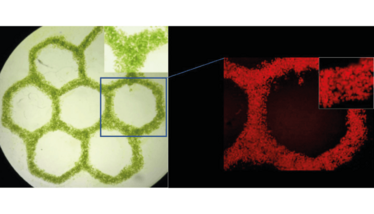Cross-Kingdom Collaboration
Tissue engineers combine plant and human cells for the first time

In recent years, 3D bioprinting techniques have been used to fabricate tissues for biomedical applications. But, despite advances in bioink technology, maintaining sufficient oxygen levels throughout remains a major limiting factor.
Now, researchers at Harvard Medical School have developed a 3D-printed algae-based biomaterial that provides a sustainable source of oxygen for the growth of human cells in engineered tissue (1).
The photosynthesizing algae supply mammalian cells within a volumetric matrix-like construct with a "natural, eco-friendly, cost-effective, and sustainable source" of oxygen, which can supports the development of engineered tissues and tissue models.
“The study is the first true example of symbiotic tissue engineering combining plant cells and human cells in a physiologically meaningful way, using 3D bioprinting,” said senior study author Y. Shrike Zhang (2).
- S Maharjan et al., “Symbiotic Photosynthetic Oxygenation within 3D-Bioprinted Vascularized Tissues” (2020). Available at: https://bit.ly/3q1zY0J.
- Eurekalert, “Algae breathe life into 3D engineered tissues” (2020). Available at: https://bit.ly/2KD2xkE.

Over the course of my Biomedical Sciences degree it dawned on me that my goal of becoming a scientist didn’t quite mesh with my lack of affinity for lab work. Thinking on my decision to pursue biology rather than English at age 15 – despite an aptitude for the latter – I realized that science writing was a way to combine what I loved with what I was good at.
From there I set out to gather as much freelancing experience as I could, spending 2 years developing scientific content for International Innovation, before completing an MSc in Science Communication. After gaining invaluable experience in supporting the communications efforts of CERN and IN-PART, I joined Texere – where I am focused on producing consistently engaging, cutting-edge and innovative content for our specialist audiences around the world.



















